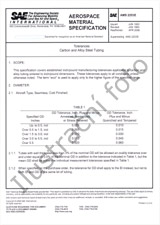Potřebujeme váš souhlas k využití jednotlivých dat, aby se vám mimo jiné mohly ukazovat informace týkající se vašich zájmů. Souhlas udělíte kliknutím na tlačítko „OK“.

Informace o normě:
Označení normy: SAE J473
Datum vydání normy: 1.8.2018
Kód zboží: NS-857691
Země: Americká technická norma
Kategorie: Technické normy SAE
Anotace textu normy SAE J473 :
The choice of the type and grade of solder for any specific purpose will depend on the materials to be joined and the method of applying. Those with higher amounts of tin usually wet and bond more readily and have a narrower semi-molten range than lower amounts of tin.
For strictly economic reasons, it is recommended that the grade of solder metal be selected that contains least amount of tin required to give suitable flowing and adhesive qualities for application.
All the lead-tin solders, with or without antimony, are usually suitable for joining steel and copper base alloys. For galvanized steel or zinc, only Class A solders should be used. Class B solders, containing antimony usually as a substitute for some of the tin or to increase strength and hardness of the filler metal, form intermetallic antimony-zinc compounds, causing the joint to become embrittled. Lead-tin solders are not recommended for joining aluminum, magnesium, or stainless steel.
Permissible impurity levels are shown:
In dipping solders, 0.5% max copper is permissible because of pickup in bath.
Compositions, temperatures, and similar specifications of these SAE solders are shown in Table 1.
SUBFILE: Automotive
TYPE OF DOCUMENT: Ground Vehicle Standard
Stabilized: Aug 2018 
Doporučujeme:
Aktualizace zákonů
Chcete mít jistotu o platnosti užívaných předpisů?
Nabízíme Vám řešení, abyste mohli používat stále platné (aktuální) legislativní předpisy.
Chcete vědět více informací? Podívejte se na tuto stránku.



 Cookies
Cookies
